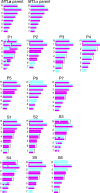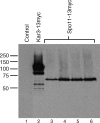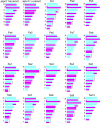The parasexual cycle in Candida albicans provides an alternative pathway to meiosis for the formation of recombinant strains
- PMID: 18462019
- PMCID: PMC2365976
- DOI: 10.1371/journal.pbio.0060110
The parasexual cycle in Candida albicans provides an alternative pathway to meiosis for the formation of recombinant strains
Abstract
Candida albicans has an elaborate, yet efficient, mating system that promotes conjugation between diploid a and alpha strains. The product of mating is a tetraploid a/alpha cell that must undergo a reductional division to return to the diploid state. Despite the presence of several "meiosis-specific" genes in the C. albicans genome, a meiotic program has not been observed. Instead, tetraploid products of mating can be induced to undergo efficient, random chromosome loss, often producing strains that are diploid, or close to diploid, in ploidy. Using SNP and comparative genome hybridization arrays we have now analyzed the genotypes of products from the C. albicans parasexual cycle. We show that the parasexual cycle generates progeny strains with shuffled combinations of the eight C. albicans chromosomes. In addition, several isolates had undergone extensive genetic recombination between homologous chromosomes, including multiple gene conversion events. Progeny strains exhibited altered colony morphologies on laboratory media, demonstrating that the parasexual cycle generates phenotypic variants of C. albicans. In several fungi, including Saccharomyces cerevisiae and Schizosaccharomyces pombe, the conserved Spo11 protein is integral to meiotic recombination, where it is required for the formation of DNA double-strand breaks. We show that deletion of SPO11 prevented genetic recombination between homologous chromosomes during the C. albicans parasexual cycle. These findings suggest that at least one meiosis-specific gene has been re-programmed to mediate genetic recombination during the alternative parasexual life cycle of C. albicans. We discuss, in light of the long association of C. albicans with warm-blooded animals, the potential advantages of a parasexual cycle over a conventional sexual cycle.
Conflict of interest statement
Figures







Comment in
-
Birds do it, bees do it, but Candida albicans does it differently.PLoS Biol. 2008 May;6(5):e121. doi: 10.1371/journal.pbio.0060121. Epub 2008 May 6. PLoS Biol. 2008. PMID: 20076710 Free PMC article. No abstract available.
Similar articles
-
Mechanistic plasticity of sexual reproduction and meiosis in the Candida pathogenic species complex.Curr Biol. 2009 Jun 9;19(11):891-9. doi: 10.1016/j.cub.2009.04.058. Epub 2009 May 14. Curr Biol. 2009. PMID: 19446455 Free PMC article.
-
A 'parameiosis' drives depolyploidization and homologous recombination in Candida albicans.Nat Commun. 2019 Sep 26;10(1):4388. doi: 10.1038/s41467-019-12376-2. Nat Commun. 2019. PMID: 31558727 Free PMC article.
-
Completion of a parasexual cycle in Candida albicans by induced chromosome loss in tetraploid strains.EMBO J. 2003 May 15;22(10):2505-15. doi: 10.1093/emboj/cdg235. EMBO J. 2003. PMID: 12743044 Free PMC article.
-
The parasexual lifestyle of Candida albicans.Curr Opin Microbiol. 2015 Dec;28:10-7. doi: 10.1016/j.mib.2015.06.017. Epub 2015 Jul 25. Curr Opin Microbiol. 2015. PMID: 26210747 Free PMC article. Review.
-
[Mating types, sexual reproduction and ploidy in fungi: effects on virulence].Mikrobiyol Bul. 2009 Jul;43(3):507-13. Mikrobiyol Bul. 2009. PMID: 19795629 Review. Turkish.
Cited by
-
High-Resolution SNP/CGH Microarrays Reveal the Accumulation of Loss of Heterozygosity in Commonly Used Candida albicans Strains.G3 (Bethesda). 2011 Dec;1(7):523-30. doi: 10.1534/g3.111.000885. Epub 2011 Dec 1. G3 (Bethesda). 2011. PMID: 22384363 Free PMC article.
-
Phenotypic Consequences of a Spontaneous Loss of Heterozygosity in a Common Laboratory Strain of Candida albicans.Genetics. 2016 Jul;203(3):1161-76. doi: 10.1534/genetics.116.189274. Epub 2016 May 20. Genetics. 2016. PMID: 27206717 Free PMC article.
-
Experimental Hybridization in Leishmania: Tools for the Study of Genetic Exchange.Pathogens. 2022 May 14;11(5):580. doi: 10.3390/pathogens11050580. Pathogens. 2022. PMID: 35631101 Free PMC article. Review.
-
Whole genome sequencing of experimental hybrids supports meiosis-like sexual recombination in Leishmania.PLoS Genet. 2019 May 15;15(5):e1008042. doi: 10.1371/journal.pgen.1008042. eCollection 2019 May. PLoS Genet. 2019. PMID: 31091230 Free PMC article.
-
Evolution of mating within the Candida parapsilosis species group.Eukaryot Cell. 2011 Apr;10(4):578-87. doi: 10.1128/EC.00276-10. Epub 2011 Feb 18. Eukaryot Cell. 2011. PMID: 21335529 Free PMC article.
References
-
- Kassir Y, Adir N, Boger-Nadjar E, Raviv NG, Rubin-Bejerano I, et al. Transcriptional regulation of meiosis in budding yeast. Int Rev Cytol. 2003;224:111–171. - PubMed
-
- Edmond MB, Wallace SE, McClish DK, Pfaller MA, Jones RN, et al. Nosocomial bloodstream infections in United States hospitals: a three-year analysis. Clin Infect Dis. 1999;29:239–244. - PubMed
-
- Ruhnke M, Maschmeyer G. Management of mycoses in patients with hematologic disease and cancer: review of the literature. Eur J Med Res. 2002;7:227–235. - PubMed
-
- Eggimann P, Garbino J, Pittet D. Epidemiology of Candida species infections in critically ill non-immunosuppressed patients. Lancet Infect Dis. 2003;3:685–702. - PubMed
Publication types
MeSH terms
Substances
Grants and funding
LinkOut - more resources
Full Text Sources
Other Literature Sources
Molecular Biology Databases

